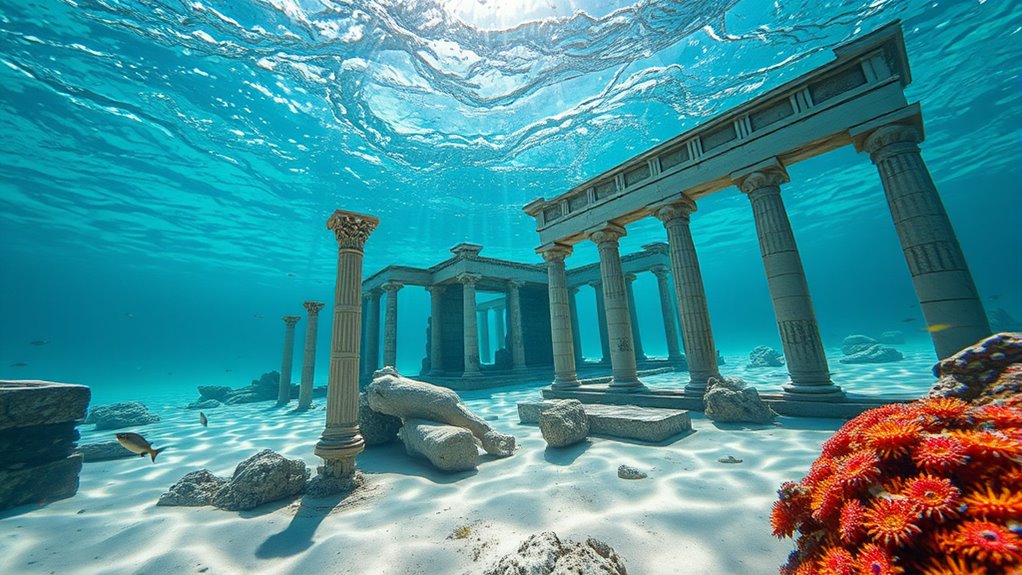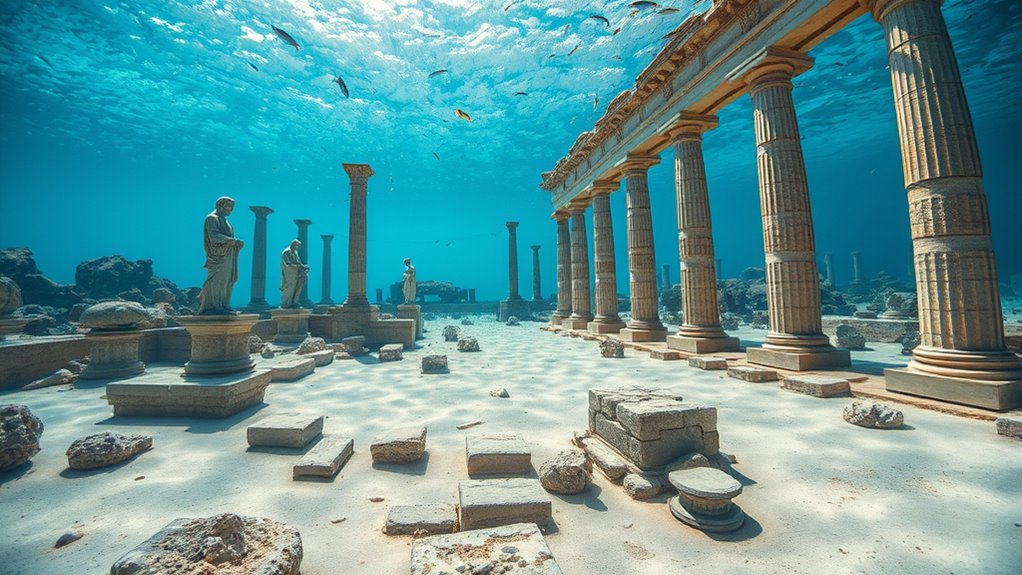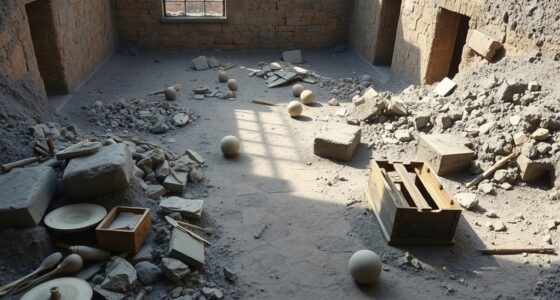You’ve discovered that a well-preserved ancient Greek city has been found beneath the Mediterranean’s surface. Using advanced underwater exploration techniques, archaeologists uncovered ruins like streets, temples, and artifacts such as pottery and statues. These relics reveal details about daily life and the city’s prosperity. However, the site faces threats like looting and climate change. Exploring these discoveries helps you understand past civilizations—and there’s much more to uncover beneath the waves.
Key Takeaways
- An ancient Greek city has been discovered beneath the Mediterranean Sea, revealing well-preserved streets, temples, and artifacts.
- Advanced underwater exploration techniques, including sonar mapping and ROVs, facilitated the site’s identification.
- The site’s artifacts, such as pottery and statues, offer insights into the city’s prosperous past and daily life.
- Preservation efforts are underway to protect the site from threats like looting, pollution, and climate change.
- The discovery enhances understanding of ancient Greek civilization and highlights the importance of underwater archaeology.

Have you ever wondered what lies beneath the waves? Beneath the shimmering surface of the Mediterranean, a remarkable discovery has come to light—a sunken city believed to be part of ancient Greece. This find is a testament to the power of marine archaeology and underwater exploration, revealing secrets buried for centuries just out of reach until now. As you consider this incredible site, imagine the stories it holds: bustling streets, grand temples, and everyday life frozen in time beneath the water’s surface. Researchers and divers have long known that beneath the waves lie remnants of civilizations lost to history, but each new discovery rewrites what we thought we knew.
The process of uncovering this ancient city involves meticulous underwater exploration. Specialists in marine archaeology navigate the depths with advanced technology, using sonar mapping, remotely operated vehicles, and dive teams to piece together the site’s layout. The submerged structures, including walls, foundations, and artifacts, tell a story of a thriving Greek settlement that once thrived on the coast. As you follow their work, you realize that every artifact recovered—from pottery shards to statues—adds another layer to the narrative of the past. These discoveries aren’t just relics; they’re windows into a civilization that flourished centuries ago and was swallowed by the sea due to natural events like earthquakes or rising sea levels. Marine archaeology techniques are continually advancing, allowing us to explore these submerged worlds more effectively.
Your curiosity might be piqued by how marine archaeology helps bring such ancient cities back to life. Underwater exploration isn’t merely about finding artifacts; it’s about understanding how people lived, traded, and interacted with their environment. Modern techniques allow archaeologists to preserve delicate features and document the site in high detail. This preservation is essential because many of these sites face threats from looting, pollution, and climate change. By studying the site carefully, experts can develop plans to protect it for future generations, ensuring that this piece of Greek history remains intact beneath the waves.
As you consider this sunken city, it becomes clear how significant marine archaeology is for uncovering lost worlds. Every dive and every scan brings us closer to understanding ancient civilizations that once flourished along the Mediterranean coast. Underwater exploration has transformed the way we view history, revealing that some of the most compelling stories are still waiting beneath the water’s surface. This discovery not only enriches our knowledge of Greek history but also highlights the importance of protecting these submerged cultural treasures. In essence, the sea continues to be a vast, mysterious archive, inviting us to explore its depths and uncover the past’s hidden chapters.
Frequently Asked Questions
What Is the Estimated Age of the Sunken City?
You’re curious about the estimated age of this sunken city. Based on archaeological dating and ancient chronology, experts believe it dates back to around 2,500 to 3,000 years ago. These methods help determine the city’s age by analyzing artifacts and structural remains. You can appreciate how these techniques provide a glimpse into its historical timeline, revealing a fascinating glimpse into ancient Greek civilization and its long-lost urban landscape beneath the Mediterranean waves.
How Deep Below the Ocean Surface Is the City Located?
Imagine peering into a hidden world beneath the waves, where marine archaeology uncovers secrets. The city lies approximately 40 meters below the ocean surface, a delicate cityscape preserved under layers of water. Through advanced underwater mapping, experts navigate this submerged wonder, revealing its structure and stories. You’d feel like an explorer in a watery tomb, revealing history piece by piece through cutting-edge technology and underwater exploration.
What Artifacts Have Been Recovered From the Site?
You find that artifacts recovered from the site include ancient pottery and bronze sculptures. These items reveal valuable insights into the city’s history and daily life. The pottery, often decorated with intricate designs, helps date the city and understand its trade connections. The bronze sculptures, preserved remarkably well, showcase the artistry and cultural significance of the period. These discoveries deepen your understanding of this ancient Mediterranean civilization.
Are There Any Legends or Myths Associated With This City?
You might think ancient mythology and legendary tales are just stories, but this city’s discovery breathes life into those legends. Some believe it’s linked to mythic tales of gods, monsters, and epic battles, making it seem almost too incredible to be true. As you explore the site, you realize that these legends could be rooted in real history, blurring the line between myth and reality in the most astonishing way.
What Technologies Were Used to Discover and Explore the Site?
You use advanced underwater remote sensing and marine archaeology tools to discover and explore submerged sites. These technologies include sonar imaging, which creates detailed maps of the seafloor, and remotely operated vehicles (ROVs) that capture high-resolution images and videos. These tools help you explore difficult-to-reach areas, uncover hidden structures, and gather vital data without disturbing the site, making underwater exploration safer and more efficient.
Conclusion
As you peer into this submerged relic, it’s like uncovering a whispered secret from the depths of time. This sunken city is a shimmering ghost, silently telling stories of ancient lives lost to the relentless embrace of the Mediterranean. Every stone and column is a sentence in a forgotten book, waiting for curious minds like yours to bring its history back to life. Plunge in, and let the ocean’s mysteries rewrite your view of the past.









